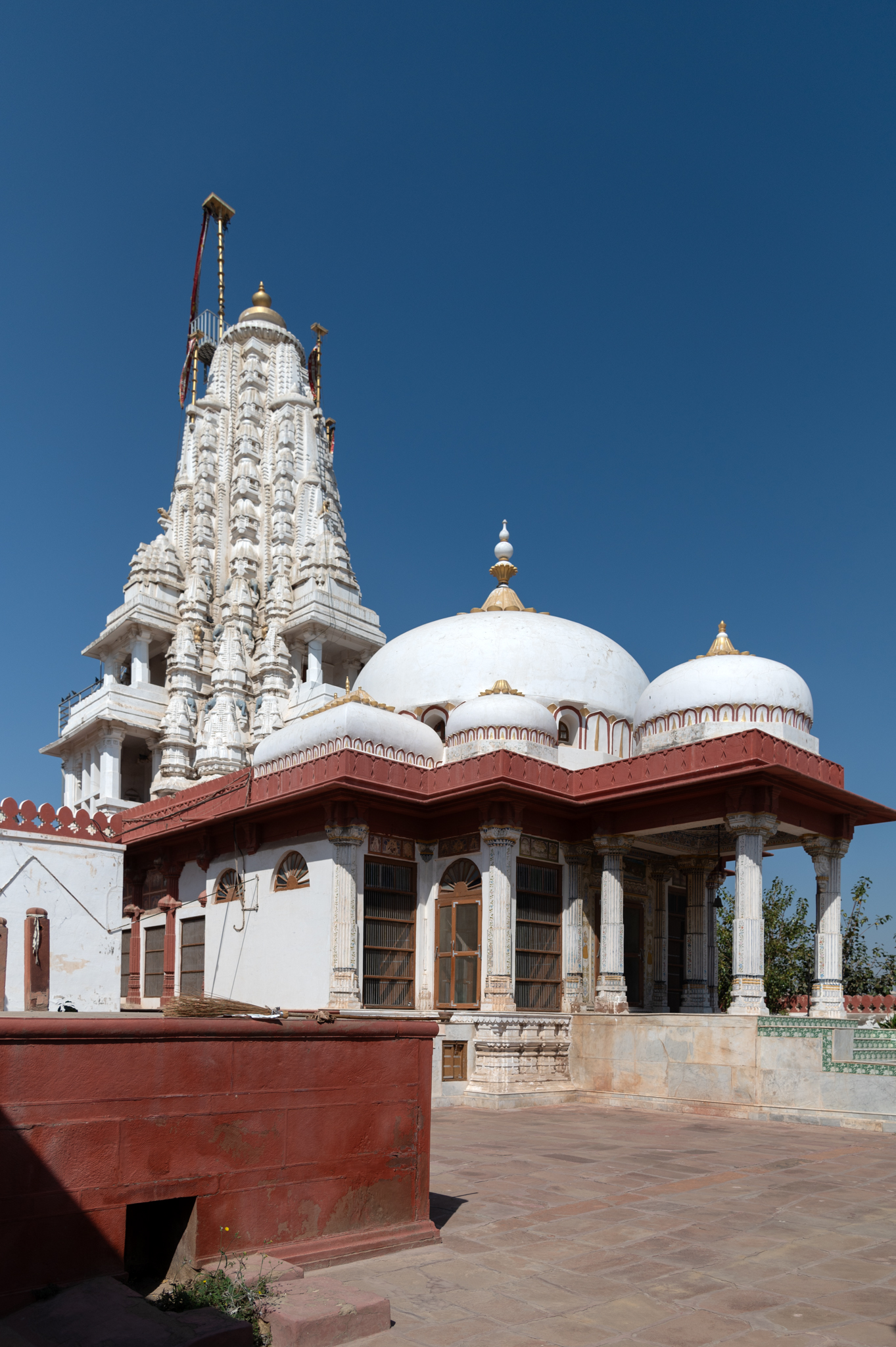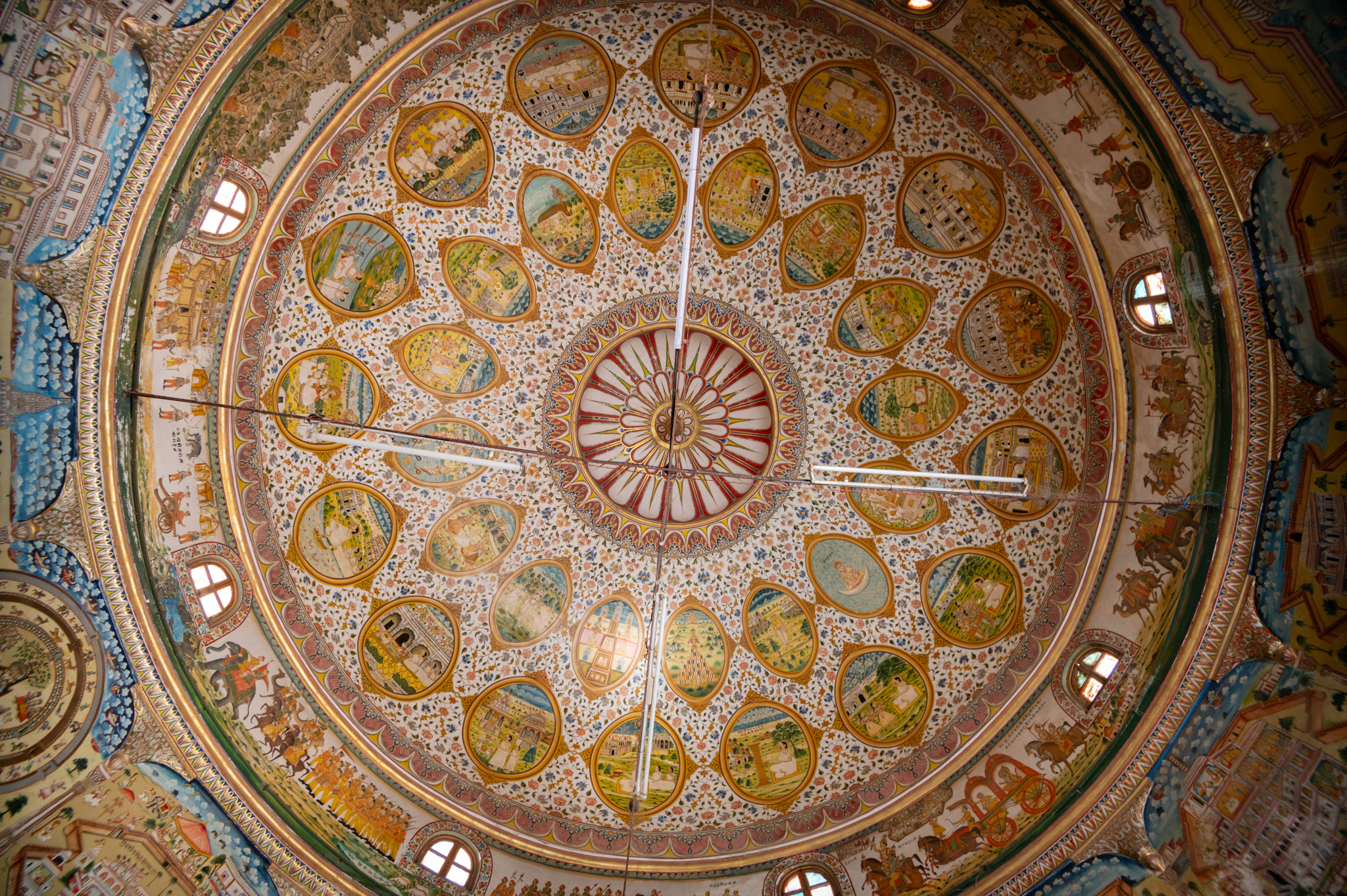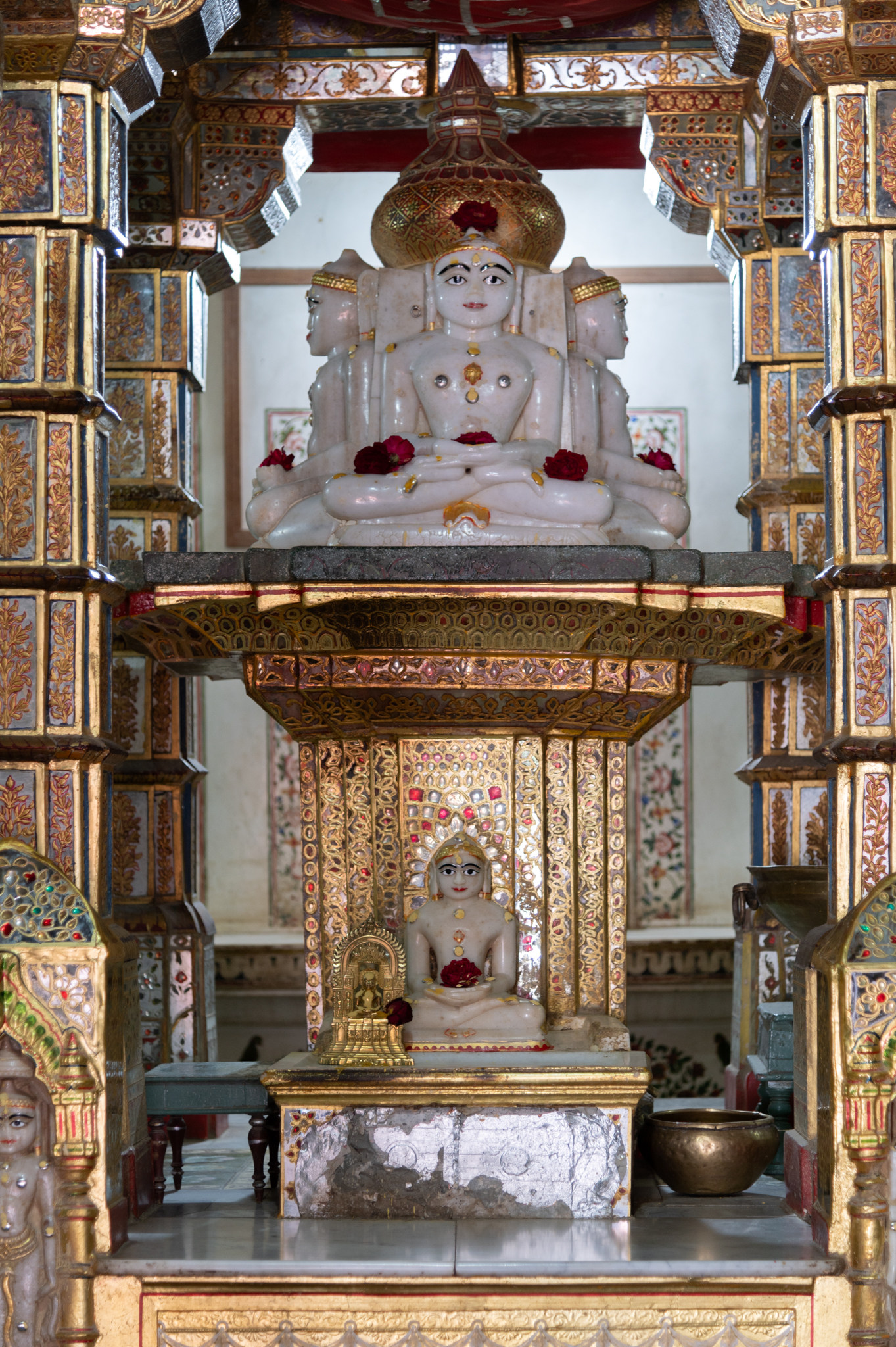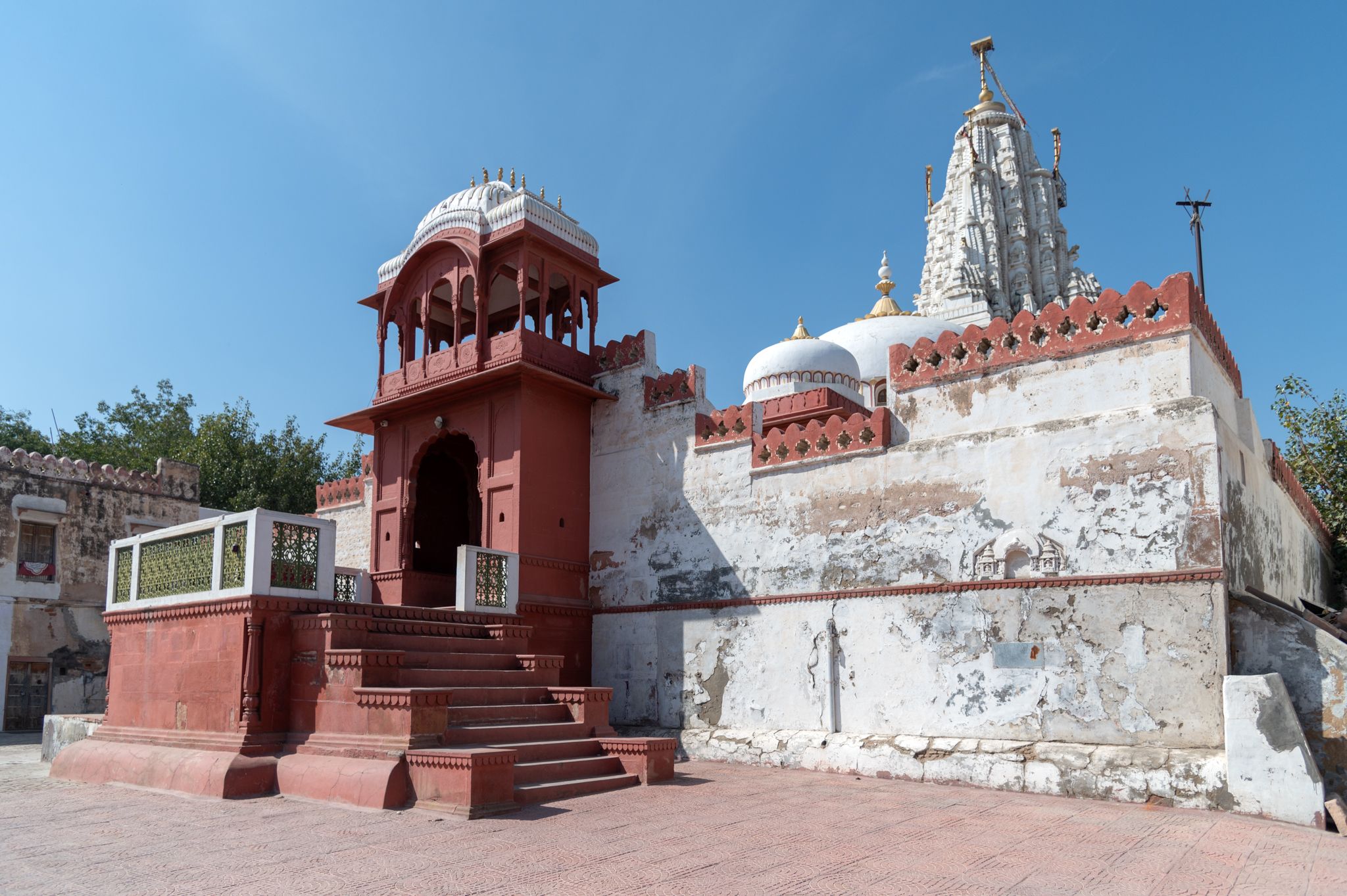A Temple Built Before the City: The Seth Bhandasar Jain Temple of Bikaner
By Swapna Joshi
Seth Bhandasar Jain Temple, situated in the heart of Bikaner, is dedicated to the 5th Jain Tirthankara, Sumatinath. It is one of the oldest Jain temples in Bikaner, located inside the old fortification wall of the city. Remnants of this old wall still stand at several locations in the present settlement. The imposing temple is in the Bada Bazaar area of Bikaner, next to another equally famous temple known as the Lakshminathji ka Mandir. The uppermost floor of the Bhandasar Temple provides a scenic view of the skyline of the Bikaner city. It is believed by the people of Bikaner that this temple was built before the city was settled. [1] There is no historical evidence to substantiate this claim, and it appears as a mere attempt to claim a greater antiquity (and therefore an almost mythical significance) for the temple. It is, therefore, no surprise that the people of Bikaner consider the Bhandasar Jain Temple as a site that defines the history of the city. Such stories often convey peoples’ perceptions about their city’s heritage and highlight the relationship of the people with the temple.
The Bhandasar Jain Temple was first built sometime during the 16th century. This is based on inscriptional evidence as well as the architectural style of the temple. Since its original construction, the temple structure has undergone several alterations, renovations, and restorations. While the mulaprasada (main shrine) and the garbhagriha (sanctum sanctorum) have relatively few changes, the mandapa (pillared hall) and the mukhamandapa (front) of the temple have undergone many changes. In the Archaeological Survey of India (ASI) Jaipur Circle’s Inventory of Monuments and Sites of National Importance, the Bhandasar Jain Temple is said to have been constructed in the 12th century CE with restorations in the following centuries. [2] The original stone surfaces of the temple walls have been painted over several times, making it difficult to date the temple. It is possible that the main shrine of the temple was built at an earlier date than the outer walls of the temple. Presently, the temple is nominally under the jurisdiction of the ASI, Jaipur Circle, but a private trust run by the Jain Oswal community in Bikaner looks after the site. Hermann Goetz has discussed the Bhandasar Temple while describing a few other significant temples of Bikaner, such as the Chintamani, Lakshminatha, and Neminatha temples. [3]
Architectural description of the temple complex
Bounded by a low enclosure wall and entered through a simple pratoli (entrance gateway) (Image 1), the Bhandasar Jain Temple is on an elevated ground compared to the surrounding area. The outermost gate of the temple complex, which is to the north-east of the complex, has the name of the temple written in Devanagari: ‘Shri Sumati Nath Jain Mandir’ and ‘Seth Bhanda Shah Ji ka Mandir.’ These two identities of the temple, first as the temple dedicated to the Jain Tirthankara Sumatinath and second as the temple of Seth Bhanda Shah, are both well-known locally. Once inside the premises, there is ample open space. In the southwestern corner of the complex are residential spaces belonging to people from the community. At the centre of this compound is a flight of steps that reach the main entrance gateway to the temple complex. This pratoli is in the form of a semi-open double-storeyed gateway. The ground floor of this structure has an opening on each side, like sentry posts in military architecture. In this temple, the spaces resembling sentry posts are built to be used as places to rest in the vicinity of God. The principal entrance of the gateway is marked by an ornate doorframe comprising a foliated arch with supporting fluted columns. Above the arch is an image of a jina carved in low relief. Above the jina is an ornamental, patterned band of foliage and an inscription, which provides a date and attribution for the temple. This inscription is a copy of an earlier inscription from the inner side of a mandapa beam when the enclosure wall and entrance gateway were added to the temple premises. The second storey of the gateway can be accessed via a staircase inside the compound. It has a small balcony capped with a bangla roof. The balcony is on the primary axis of the Bhandasar Temple.
Inside the enclosure wall, there is a small shrine dedicated to the first Jain Tirthankara Adinatha to the right of the main temple. A preliminary comparison between the main temple and this shrine suggests that both structures are contemporary. However, the Adinatha Temple is smaller in scale compared to the Bhandasar one. The temple was designed to have a semi-open mandapa connected to a square mandapa, an elongated antarala (vestibule), and finally, the garbhagriha. The mandapa walls have foliated arches beautified with intricate floral designs. The use of marble with a contrasting colour scheme gives the temple a vibrant appearance.
The main Bhandasar Temple is a fairly well-preserved structure, owing to the timely renovations. With its principal ingress facing east, the temple is sandhara that, is, there is an enclosed pradakshina path (circumambulatory path) between the main shrine and the outer walls of the temple building. There are two possibilities: that this feature was part of the original design or that the outer walls were built later encasing the temple. The temple has a shekhari (multi-spired) style of spire built in stone. (Image 2) It is painted white, in contrast to the red colour of the main shrine. The cardinal directions of the shikhara (superstructure) have long spines known as madhyalatas—these are further decorated on their surface with miniatures of the same design. The four quadrants between the cardinal latas are covered with shikhara aedicules. The ascending superstructure has the effect of an elongated tower above the main shrine.

The garbhagriha is a pancharatha type of ground plan—the mulaprasada of the temple is composed of five projections, bhadra (principal projection) flanked by a pratiratha (intermediate projection) and a karna (corner projection). (Image 3) All these offsets are separated from each other by recesses called the salilantaras. This interplay of projections and recesses creates the form of the outer walls of the main sanctum. These walls have a sequence of different base mouldings. The central portions of the jangha (wall) are bedecked with sculptures depicting deities, demi-gods, ascetics, and damsels. The principal projections of the garbhagriha do not have any sculpture because the garbhagriha is of the sarvatobhadra variety, that is, all its four walls are punctured with entrances at the centre. Although only the entrance facing the east is currently in use to access the interior of the sanctum, originally, one could enter from any direction. The stone has been painted over, making it colourful and vibrant. However, because of the thick layers of paint, it is now very difficult to identify the sculptures. For instance, the intermediate projections of the sanctum are likely to have depictions of the dikpalas (deities of the cardinal directions). For example, the southwestern corner has a depiction of Indra, identified by the elephant sculpture at the bottom. However, not all such sculptures can now be identified based on the iconography.

The exterior walls of the temple are divided into bays, each defined by fluted pillars. The walls of the temple are rather plain and have been painted in white and red ochre, with occasional paintings of Krishna on the upper parts of the wall. These paintings are peculiar as they were originally made in the Matheran Kala, a painting style developed in Bikaner itself. They are narrative scenes based on Krishna’s life and use bright colours with fine brush strokes. Bikaneri miniature painting and Matheran Kala done on walls are subsets of Bikaneri printings, which in turn are subschools of Rajasthani paintings. There is a remarkable similarity between the Matheran Kala and the Bikaneri styles of miniature painting. The latter is derived from the earlier Mughal-Rajput painting style. This Matheran Kala can be found in older palaces like the Lalgarh Palace of Bikaner.
On the interior, the temple has an astylar mandapa with a dome above it (all the supporting pillars of the mandapa are on the periphery of the dome and none in the centre) and beautiful paintings on the inner walls and ceiling of the temple. (Image 4) There are three bands of different paintings on the ceiling. These paintings were originally made in the idiom of the Usta Kala of Bikaner and have since been retouched. The lowermost bands along the beams of the dome have paintings that depict Bikaner cityscapes. The 16-sided dome (Image 5) in the mandapa of the temple has two sets of paintings: one is the life journey of Jain Tirthankara Neminatha, and the other set consists of beautiful proverbs from the Jain religion depicted in the form of stories. These paintings use gold embossing, one of the essential aspects of Usta Kala. Made in oval shapes on the interior of the dome, each painting has an inscription stating the story of the painting. Other circular bands have paintings depicting the life and miraculous deeds of Jinachandra Suriji and Jinaprabha Suriji. These were two significant figures, two of the four Dada Gurus of the Shvetambara sect of the Jain religion. [4] Such paintings are also found in the Junagarh fort of Bikaner. Even the pillars and ceilings of the aisles in the Bhandasar Jain Temple have similar floral art. The inner side of the outer walls of the temple has openings at regular intervals. The frames of these openings have various paintings of Jain tirthankaras and stories based on proverbs. The ceiling of the vestibule, that is, the passage in front of the sanctum sanctorum, has paintings of Jain tirthankaras from the southern to the northern wall.


The doorway of the garbhagriha is beautifully adorned with golden embossed metal sheets. The doorframe of the entrance to the garbhagriha has an image of Jina on the lintel. In the shrine is a sarvatobhadra statue of Sumatinath made of marble. (Image 6)

Who built the Seth Bhandasar Jain Temple?
The question of who built the Seth Bhandasar Jain Temple in Bikaner can be partially answered by its moniker. It is believed that a Sethia (merchant) named Bhanda Shah, who belonged to the Oswal clan, is credited with the construction of this temple. The inscription inside the temple dates to VS 1521 (1464 CE). (The date in the inscription is not clear and might also read as 1571). The inscription mentions the name Rao Lunkaran, son of Rao Bika, who ruled Bikaner in the early 16th century. As mentioned earlier, the same inscription has also been copied above the doorframe of the main entrance to the temple. Although the precise date of temple construction remains unclear, it can be argued that the Bhandasar Temple was first built sometime between the 15th and 16th centuries.
An interesting legend associated with the construction of the temple, as narrated by the caretaker of the temple, is about a hermit roaming around a village named Naal, apparently not very far away from Bikaner. While wandering, the hermit reached the residence of Bhanda Shah, a merchant of ghee (clarified butter). Bhanda Shah was asked to hold onto the hermit’s valuables and personal belongings until he came back from a trip he was going on. The hermit then left and only returned after almost a decade. Upon his return, the hermit asked Bhanda Shah to return his belongings. At this point, Bhanda Shah behaved nonchalantly and informed the hermit that his possessions had been misplaced. The hermit realized that Bhanda Shah was lying and, infuriated by this behaviour, cursed Bhanda Shah with an inability to have children. The merchant then realized his mistake and attempted to pacify the hermit with apologies, but the curse could not be withdrawn. Bhanda Shah was asked to patronize a temple to ameliorate the effects of the curse. A cow was sent out from the village, and the place where the cow gave milk was decided as the location of the temple. Since Shah sold ghee, the foundation of the temple was laid with ghee. About 1,000 quintals of ghee were used for the construction of the temple. It is still believed that during summers, ghee oozes out of the foundation and wall masonry of the temple. Owing to this legend, the temple is locally also known as the ‘ghee se bana mandir.’
There is another story regarding the construction of the temple by Bhanda Shah, in which, during the ongoing construction of the temple, a lamp containing clarified butter was lit inside. A fly accidentally fell into this lamp full of ghee, and Bhanda Shah, who was present there, removed the fly from the lamp and rubbed it on his feet to use the ghee that was stuck to its body. The architect of the temple saw this and found it very miserly of Shah to have not even spared a fly. The architect called Bhanda Shah kanjoos makhichoos (a stingy and miserly person). Following this allegation, Bhanda Shah donated huge amounts of ghee for the construction of the temple. He wanted to disprove the architect’s accusation by extending a generous donation to the temple. The aspect of the use of ghee for laying the foundation of the temple is narrated in this story as well. The locals of Bikaner and the communities devoted to the temple, especially the Oswals, take pride in reiterating this aspect. Thus, the construction of Seth Bhandasar Jain Temple was a product of the merchant’s generous donations. A common thread in both tales is that the temple inherited its name, Bhandasar, from its donor, Seth Bhanda Shah.
According to a legend, the construction of the Bhandasar Temple predates the foundation of Bikaner by Rao Bika. Hence, it is famous as the temple that was built before the city. Even though it might be historically difficult to prove this claim, Bhandasar temple is certainly one of Bikaner’s oldest buildings.
Footnotes:
[1] Sehgal, Rajasthan District Gazetteers Bikaner, 416.
[2] Joshi, Inventory of Monuments, 68.
[3] Goetz, The Art and Architecture of Bikaner State, 60–61.
[4] Babb, ‘Monks and Miracles,’ 13.
Bibliography:
Babb, L. A. ‘Monks and Miracles: Religious Symbols and Images of Origin among Osval Jains’. The Journal of Asian Studies 52, no. 1 (1993): 3–21. https://doi.org/10.2307/2059142.
Goetz, Hermann. The Art and Architecture of Bikaner State. Oxford: Published for Government of Bikaner State and the Royal India and Pakistan Society by Bruno Cassirer, 1950.
Sehgal, K.K. Rajasthan District Gazetteers Bikaner, Gazetteer of India, Jaipur: Directorate District Gazetteers, Government of Rajasthan, 1962.
Joshi, Jagat Pati. Inventory of Monuments and Sites of National Importance volume 2, part 1, Jaipur: Archaeological Survey of India, 1999.
